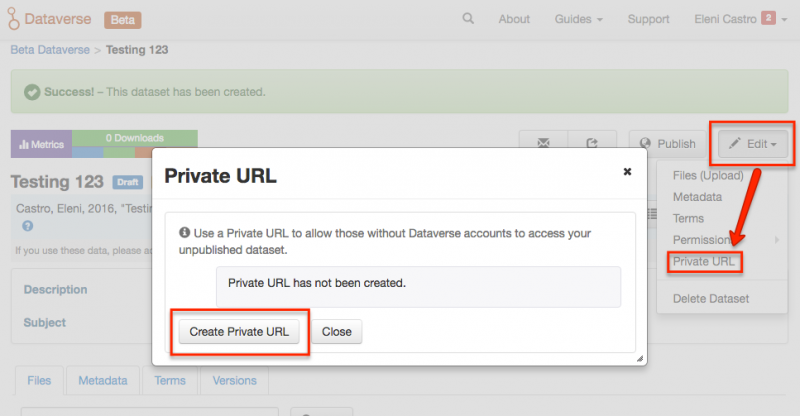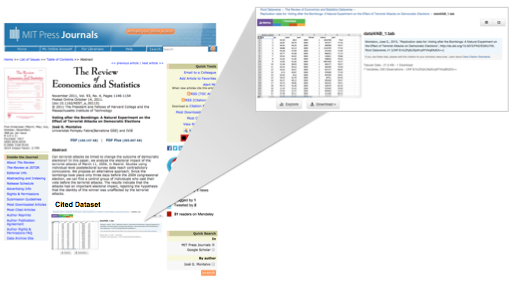 Are you a publisher looking for a data sharing solution for your journals? Or do you have a journal and are looking for a place to reliably host your author’s data? This blog post will explain some of the ways journals can use Dataverse and will preview some upcoming functionality which will be tailored to journals.
Are you a publisher looking for a data sharing solution for your journals? Or do you have a journal and are looking for a place to reliably host your author’s data? This blog post will explain some of the ways journals can use Dataverse and will preview some upcoming functionality which will be tailored to journals.
Why Choose Dataverse for Your Journal?
Having a dataverse allows journals to seamlessly manage the submission, review, and publication of data, while displaying it on their site alongside published articles. Authors can easily and quickly deposit data associated with a journal article in Dataverse, while journal editors can efficiently review and publish the data.
Having a dataverse increases your journal’s visibility and impact through:
-
formal citation credit (via a scholarly data citation) for your author's data
-
helping your authors to meet funder mandates
-
enabling others to reproduce the findings in your journal’s articles
-
participating in the open data movement by using Dataverse as part of your journal data policy
Need help setting up your dataverse or want to schedule a training? Our support team can lead trainings for you and your team virtually or in person. Contact us at support@dataverse.org.
Example of a Publisher (Ubiquity Press) hosting multiple journals in the Harvard Dataverse (link)
Current options for using Dataverse for your journal(s):
Recommend Dataverse to Authors
This is a low maintenance option since journal’s can simply include Dataverse in your data policy as a recommended data repository for authors to deposit their research data into and receive a formal scholarly data citation to include with their published article. The Harvard Dataverse is available to any researcher from any discipline to deposit data. Here are some examples of journals and publishers recommending Harvard Dataverse for authors to deposit data: PLOS, Elsevier, Nature Scientific Data, and American Heart Association Publications.
Setup a Journal Dataverse
Having your own dataverse for your journal allows you to have more control over organizing and reviewing what datasets are linked to your publications, and can be easily displayed on your site. When an article is accepted for publication, authors can be instructed to deposit their data in your journal's dataverse. Once an author submits a dataset for review, the journal editor will be sent an email notification to review and publish the data associated with their articles. The Harvard Dataverse currently has 84 published journal dataverses and is open for any journal (of any discipline) interested in creating a journal dataverse within it. Here are some examples of journals which are in the Harvard Dataverse: Palgrave Communications, Political Analysis, and the recently added Quarterly Journal of Economics.
Setup a Journal Dataverse with Third Party Data Curation & Verification
Journals interested in making sure datasets associated with their articles are replicable can setup a Dataverse where authors can deposit their replication datasets, which then go through a thorough curation and verification process performed by an independent third-party. This service is currently offered by the UNC Odum Institute. Some examples include: American Journal of Political Science (AJPS) which is hosted on Harvard Dataverse, and State Politics and Policy Quarterly (SPPQ) which is hosted on the Odum Institute Dataverse. Have questions? You can contact the Odum Archive (odumarchive@unc.edu) for more information.
Automated Integration Between Your Journal & Dataverse
This automated integration with Dataverse facilitates research data sharing and archiving so that authors are able to submit, from the journal's article submission system, their research data to Dataverse at the same time as their article. Additionally, bi-directional links are automatically made between the journal article and its underlying data.
-
This service is currently available via the Dataverse Plugin for any journal using Open Journal Systems (OJS) as their journal management system.
-
For all other publishers and journal systems interested in integrating their publication workflow with the Dataverse SWORD API we would love to integrate with you so please contact us (support@dataverse.org).
Additional Features For Journals Coming This Year
-
Private URL to share unpublished datasets to reviewers: Coming in Dataverse Summer 2016, there will be a simple way to send a private URL of an unpublished dataset for a group of peer reviewers to review the data.

-
File-level widget to preview and display dataset alongside the article. Coming later this year, authors and journals will be able to embed a specific data file (with previews for certain file types) into their articles.
